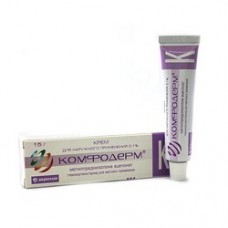Expiration date: 06/2026
Dosage form
Cream for external use 0.1% white or almost white, with low specific smell.
Composition
100 g contains:
methylprednisolone aceponate (in terms of 100% substance) 0.1 g
Other ingredients: ceramide - 0.5 g of the preservative Euxyl PE 9010 (Phenoxyethanol - 90%, Ethylhexylglycerin - 10%) in terms of Phenoxyethanol - 0.9 mg, methyl ethyl ketone and 7 g, octyldodecanol - 7 g, hexidecimal - 7 g Dimethicone 100 cst - 1 g propylene glycol and 7 g, macrogol 40 stearate - 1.5 g glyceryl monostearate - 8.5 g, cetosteatil alcohol (cetyl alcohol - 60%, stearyl alcohol - 40%) - 2 g disodium edetate 0.1 g, potassium dihydrogen phosphate - 0.49 g, sodium hydrogen phosphate, dodecahydrate - 0.01 g purified water to 100 g.
Pharmacological action
GKS for external use. Inhibits the function of leukocytes and tissue macrophages. Restricts the migration of leukocytes in the area of inflammation. Violates the ability of macrophages to phagocytosis and the formation of interleukin-1. Contributes to the stabilization of lysosomal membranes, thereby reducing the concentration of proteolytic enzymes in inflammation. Decreases capillary permeability caused by histamine release. Inhibits the activity of fibroblasts and collagen formation.
Inhibits the activity of phospholipase A2 which leads to suppression of the synthesis of prostaglandins and leukotrienes. Suppresses the release of COX (mainly COX-2), which also contributes to reduction in the production of prostaglandins.
Reduces the number of circulating lymphocytes (T - and B-cells), monocytes, eosinophils and basophils as a result of their displacement from the vascular bed to lymphoid tissue; suppresses the formation of antibodies.
Methylprednisolone aceponate suppresses the release of pituitary ACTH and b-lipotropin, but does not reduce the level of circulating b-endorphin. It inhibits secretion of TSH and FSH.
With direct application to the vessels causes vasoconstrictor effect.
When external and local application the therapeutic activity of methylprednisolone due to anti-inflammatory, antiallergic and antiexudative (due to vasoconstrictor effect) effect.
Pharmacokinetics
Methylprednisolone aceponate is hydrolysed in the epidermis and the dermis. The main and most active metabolite is 6?????-metilprednizolon-17-propionate having a much higher affinity for glucocorticosteroid receptors of the skin, which indicates the existence of its "bioactivation" in the skin.
The extent of percutaneous absorption depends on the condition of the skin, dosage forms and method of application (with or without occluzionna bandages).
After entering into the systemic circulation 6 alpha-methylprednisolone-17-propionate is quickly in contact with glucuronic acid and, thus, in the form of 6 alpha-methylprednisolone-17-propionate is inactivated by glucuronide.
The metabolites of methylprednisolone aceponate are eliminated primarily by the kidneys with a half-life of about 16 hours. Methylprednisolone aceponate and its metabolites do not koumouliruet in the body.
Method of application
Apply topically 1 time/day in a thin layer to affected area, gently rubbing. It is possible to use with occlusive bandage. Usually the treatment for adults is no more than 12 weeks, and for children not more than 4 weeks. During the year, it is possible to conduct several courses of treatment.
Overdose
In the study of acute toxicity of methylprednisolone aceponate have not identified any risk of acute intoxication by excessive of a single cutaneous application (applying the product to a large area under conditions favourable to absorption) or inadvertent ingestion. In the over-long and/or intensive topical application of corticosteroids can develop skin atrophy (thinning of the skin, telangiectasia, striae). If signs of skin atrophy the drug should be stopped.
Side effects
The incidence of side effects is classified in accordance with the recommendations of the world health organization (who): very often (>10%), often (> 1 %,< 1C %), infrequently (> 0.1 %, < 1 %), rarely (> 0,01 %, < 0.1 %), very rare (< 0,01 %). frequency unknown (to estimate the frequency of occurrence of NS possible).
Violations of the skin and subcutaneous tissue: rare perioral dermatitis, depigmentation of the skin, allergic reactions to the drug components; frequency is unknown - atrophia of the skin, telangiectasia, striae, acne-like skin changes (using the drug more than 4 weeks and/or in the area of 10 % or more of body surface).
General disorders injection site, rarely - folliculitis, hypertrichosis; very rarely - itching, burning, erythema, education vezikuleznaya rash; frequency is unknown-systemic effects caused by absorption of glucocorticosteroid (in applying the drug more than 4 weeks and/or in the area of 10 % or more of body surface).
Esli any of the instructions side effects worsen, or note any other side effects not mentioned in the instructions, you should immediately inform the doctor.
Special conditions
In the presence of bacterial dermatitis and/or ringworm in addition to drug therapy of Camphoderm® It is necessary to carry out a specific antibacterial or antimycotic treatment.
The drug is not intended for use in ophthalmology. Avoid contact with eyes and mucous membranes.
As the use of systemic corticosteroids after topical corticosteroids may develop glaucoma (e.g. the application of high doses, due to the very prolonged use of occlusive dressings or application of PA the skin around the eyes).
Effects on ability to drive vehicles and mechanisms
It is not revealed.
Testimony
Inflammatory skin disease sensitive to treatment with topical corticosteroids:
- atopic dermatitis, neurodermatitis, infantile eczema;
- true eczema;
- microbial eczema
- professional eczema;
- irritant contact dermatitis;
- allergic (contact) dermatitis;
- disgidroticheskaya eczema.
Contraindications
- tuberculous or syphilitic processes in the area of application of the drug; virus diseases (e.g. varicella, herpes zoster) in the area of application of the drug;
- rosacea, perioral dermatitis in the area of application of the drug; children up to age 4 months;
- skin manifestations of reaction to the vaccine; hypersensitivity to the drug.
- Application of pregnancy and during breastfeeding
- If necessary, use of the drug Camphoderm® during pregnancy and lactation should carefully weigh the potential risk to the fetus and potential benefits of treatment for mother. During these periods we do not recommend prolonged use of the drug in large surfaces of the skin, nursing mothers should not apply the drug on the mammary gland.
Drug interactions
Has not been studied.


